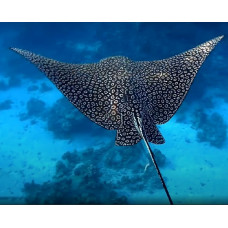Latin name
Aetobatus narinari
Other names
Aetobatus narinari
Identification
They have a flattened, disc-shaped body. The characteristic shape of the flat snout resembles a duck's nose. The jaws usually have a row of flat, chevron-shaped teeth. Each tooth is a crescent-shaped plate joined into a ring. There are no barbs on the disc. The tail is longer than other stingrays and carries 2-6 venomous spines located just behind the pelvic fins. On the underside of the long, wing-shaped pectoral disk are five small gill slits, nostrils and a mouth.
Features of fish fins
Have a small dorsal fin. The caudal fin is absent. Dorsal spines (total): 0; Dorsal soft rays (total): 0; Anal spines: 0; Anal soft rays: 0.
Fish colouring
The dorsal side is dark blue or black with white dots, the ventral side is white.
Distribution
Widespread in tropical and subtropical areas of all oceans, including the Gulf of Mexico, Hawaii, the Atlantic coast of Africa, the Indian Ocean, Oceania, and both coasts of the Pacific Ocean. In the western Atlantic, they occur from the coast of North Carolina and Florida to southern Brazil; in the Indian Ocean, from the Red Sea to southern Africa. In the eastern Pacific, from the Gulf of California to Puerto Pizarro, Peru, and near Hawaii; in the western Pacific, from Japan to Australia.
Habitat
Marine brackish benthic benthopelagic amphidromous subtropical species. Prefer water temperature of 24-27°C. Gravitate to shallow coastal waters with coral reefs and bays. Enter lagoons and river mouths. Occur from the surface to depths of 80 meters.
Size
Adults reach a length of 3.3 m (up to 8.8 m with tail), disc width up to 2.5 m, body mass up to 230 kg.
Behavior
The daily movements of stingrays are related to the tides, being more active during high tide. They are characterized by rapid movements of the belly and pelvic fins, similar to waves. When swimming alone, these movements are repeated 4-5 times in a row. When moving in a swarm, such actions are repeated regularly and more intensely. Such behaviors as diving and jumping have also been observed. When diving, fish dive sharply and then return to the original position. Two types of jumps have been observed. In the first type, the fish leaves the water vertically and then returns to the water along the same trajectory. In the second type, the ray repeatedly jumps out of the water at a 45 degree angle at high speed. They are solitary in shallow water or away from their usual feeding areas, but can form schools and swarms. One of the forms of movement in a school is called "unbound aggregation", when 3 to 16 stingrays swim in the same direction at the same speed, but have virtually no interaction with each other.
Food and feeding habits
They feed mainly on crustaceans, including mollusks, shrimps, crabs, crayfish, snails, and other benthic organisms. Of the crustaceans, the diet is dominated by higher crayfish (Malacostraca). Hermit crabs, octopuses, and small fish are also found in stomachs.
The specialized V-shaped arrangement of teeth helps stingrays grind hard shells of mollusks. There are no differences in feeding habits between males and females and between stingrays from different parts of the range.
In a behavior unique among stingrays, spotted eagle rays will bury their snouts in the sand and surround themselves with a cloud of sand that exits through their gills. In this way they prey on organisms buried in the sand.
Reproduction
Mature at the age of 4-6 years. During the breeding season, they exhibit a peculiar mating behavior. First, the male, and sometimes several males, chase the female. Then the male approaches the female, grabs her behind her back with his upper jaw, and turns her over by her pectoral fin. After turning the female onto her belly, the male inserts one of his pterygopodium into the female. The fertilization process takes 30-90 seconds. It is classified as an oviparous organism. The eggs are incubated in the female's body and hatch internally. Fry feed on yolk sac reserves before being released into the environment. Embryonic development takes about a year. The female gives birth to one to four young. The width of the disc of newborn individuals is 170-350 mm.
Fishing
Small commercial fishing.
Relationship with a person
The coloration of the upper side of the body makes these fish attractive to aquarists. Their flesh is of poor quality and is rarely used for food. Harmful to humans.
| Classification | |
| Phylum | Chordata |
| Class | Chondrichthyes |
| Squad | Myliobatiformes |
| Family | Aetobatidae |
| Genus | Aetobatus |
| Species | A. narinari |
| Features | |
| Conservation status | Endangered |
| Habitat | No information |
| Life span, years | No information |
| Maximum body weight, kg | 230 |
| Maximum length, cm | 330 |
| Sailing speed, m/s | No information |
| Threat to people | Edible |
| Way of eating | Bentophage |
Spotted eagle ray
Tags: spotted eagle ray



